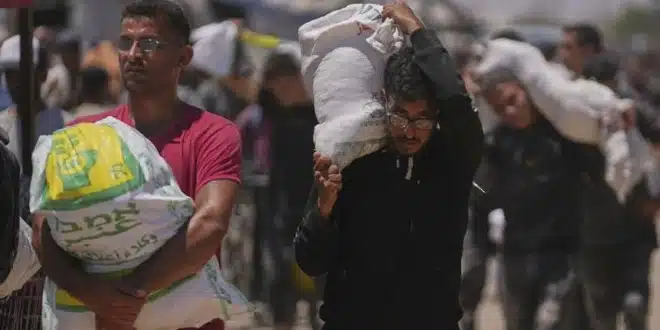An Israeli airstrike struck a street in Deir al-Balah in central Gaza on Thursday, killing 18 individuals and wounding others, according to hospital officials. The area targeted was a location where, eyewitnesses reported, local residents had gathered to receive flour and other basic goods. These supplies had been reclaimed by Palestinian police from criminal groups accused of looting humanitarian convoys.
The strike reportedly hit members of Sahm, a special security unit affiliated with the Hamas-led Interior Ministry in Gaza, though it also includes personnel from other Palestinian factions. This unit had been actively working to prevent looting and stop merchants from profiting by reselling stolen aid at inflated prices. As they distributed confiscated flour, a large crowd assembled, which became the scene of the deadly strike.
Footage from the aftermath revealed multiple fatalities, including children and members of the Sahm unit. Bloodied bodies were seen strewn across the street, and nearby buildings showed extensive damage. At least seven Sahm officers were confirmed dead by medical staff at Al-Aqsa Martyrs Hospital. The Israeli military did not immediately issue a statement addressing the strike.
Over recent weeks, new actors have emerged in Gaza’s aid landscape. A coalition of tribal leaders has independently organized protection for aid convoys, aiming to prevent looting by criminal elements. One such group, the National Gathering of Palestinian Clans and Tribes, claimed to have safeguarded a delivery of flour into northern Gaza this week. However, it remains unclear whether these efforts are coordinated with the United Nations or Israeli authorities. The World Food Program has not responded to queries on the matter.
A representative from the tribal coalition emphasized their determination to halt profiteering, noting that families are forced to buy stolen aid at unaffordable prices. The tribal initiative reflects rising frustration among Gaza’s population with the chaotic state of aid distribution and the failure of institutional actors to maintain order.
Disputes Over Responsibility and Ongoing Civilian Toll
Israel’s government, led by Prime Minister Benjamin Netanyahu and Defense Minister Israel Katz, accused Hamas in a joint statement of diverting humanitarian aid entering Gaza, particularly in the north. They instructed the military to take further steps to prevent this from happening. In response, the tribal coalition refuted the allegations, claiming their aid convoys were fully secured and accusing Israeli forces of attempting to justify military operations through false narratives.
Throughout the conflict, Israel has consistently targeted Gaza’s police and security units, viewing them as extensions of Hamas’s political and military structures. Aid organizations report that interruptions and attacks on the aid network only exacerbate instability and hunger. The United Nations has emphasized that when sufficient quantities of aid are allowed in, looting declines significantly.
Israel has also begun supporting alternative aid delivery models, backing a U.S.-based private initiative known as the Gaza Humanitarian Foundation. This group has been distributing food parcels from four distribution centers primarily located in southern Gaza. Thousands of civilians reportedly walk long distances, often traversing Israeli-controlled military zones, to reach these hubs. Witnesses have described repeated episodes where Israeli troops fire warning shots or live ammunition to disperse crowds. Health officials state that hundreds have been injured or killed near such distribution points.
On Thursday, the World Health Organization reported that it had delivered medical aid to Gaza for the first time since early March. A convoy of nine trucks brought vital supplies, including blood and plasma, to Nasser Hospital in southern Gaza, one of the last major facilities still in operation.
In a separate development, additional Israeli strikes overnight and early Thursday resulted in at least 28 deaths across the territory, according to the Gaza Health Ministry. Twenty of the casualties were received by Gaza City’s Shifa Hospital, while Nasser Hospital in the south reported eight fatalities.
Meanwhile, images from Gaza City on Thursday depicted large crowds queuing to collect flour from a recent aid delivery. Civilians, many of whom had gone months without reliable access to food, expressed relief and desperation. One mother said her children often cried from hunger, while another woman recalled how looters had deprived families of their fair share of aid.


